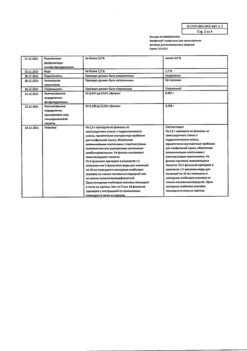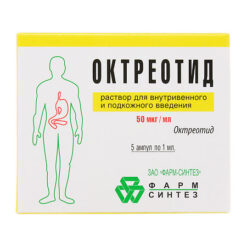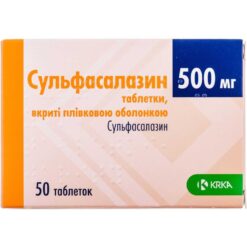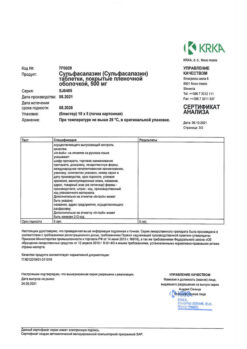No products in the cart.
Phosphogliv, capsules 50 pcs.
€16.69 €14.47
Out of stock
(E-mail when Stock is available)
Description
Pharmacodynamics
A combined agent. It has hepatoprotective, membrane stabilizing and antiviral effect.
Glycyrrhizic acid has a hepatoprotective effect due to antioxidant, anti-inflammatory effects, and effects on fibrogenesis.
Antioxidant effect. Glycyrrhizic acid binds free oxygen radicals and inhibits enzymes that initiate lipid peroxidation (LPO) in hepatocytes.
Anti-inflammatory effect. Glycyrrhizic acid reduces inflammation through its inhibitory effect on NF-kB- and TLR4-signaling pathways; inhibition of pro-inflammatory cytokine production (TNF α, IL-1, IL-6, IL-8); stimulation of anti-inflammatory cytokine production (IL-2, IL-10, IL-12).
Glycyrrhizic acid inhibits 11β-oxysteroid dehydrogenase, which contributes to an increase in endogenous cortisol in the blood (pseudocorticosteroid effect).
Influence on fibrogenesis is associated with reduction of collagen type 1 gene expression and reduction of collagen production by stellate liver cells (Ito cells), as well as destruction of activated Ito cells through the natural killer system, which helps to slow the progression of fibrosis.
Suppresses the reproduction of viruses in the liver and other organs by stimulating the production of interferons, increasing phagocytosis, increasing the activity of natural killer cells.
In case of skin lesions due to its anti-inflammatory action it limits the spread of the process and promotes the regression of the disease.
Phosphatidylcholine (the active ingredient of phospholipids) is the main structural element of cellular and intracellular membranes, restores their structure and function when damaged, having a membrane-stabilizing effect. It normalizes protein and lipid metabolism, prevents loss of enzymes and other active substances by hepatocytes and promotes restoration of liver functions.
Pharmacokinetics
Glycyrrhizic acid
. After oral administration in the intestine, under the influence of the enzyme β-glucuronidase produced by bacteria of normal microflora, glycyrrhizic acid forms an active metabolite – β-glycyrrhetic acid, which is absorbed into the systemic bloodstream. In the blood β-glycyrrhetic acid binds with albumin and is almost completely transported to the liver. Excretion of β-glycyrrhetic acid occurs mainly in bile, with residual amount in urine.
According to experimental data, phospholipids improve the lipophilic properties of glycyrrhizic acid, increasing the intensity and rate of its absorption by more than 2 times.
Phosphatidylcholine
More than 90% of ingested phospholipids are absorbed in the small intestine. Most of them are broken down by phospholipase A to 1 -acetyl-lysophosphatidylcholine, 50% of which undergoes reverse acetylation to polyunsaturated phosphatidylcholine during absorption in the intestinal mucosa. Polyunsaturated phosphatidylcholine with lymph stream enters blood, from where it is mainly bound with high density lipoproteins to liver. Pharmacokinetics in humans have been studied with dilenoleoyl phosphatidylcholine with the radioactive label -3H (choline part) and 14C (linoleic acid residue). The maximum concentration of 3H is reached after 6-24 hours, constituting 19.9% of the prescribed dose; 14C is reached after 4-12 hours, constituting 27.9%. Half-life of the choline component is 66 hours, the linoleic acid residue is 32 hours. In the stool, 2% of 3H and 4.5% of 14C are detected; in the urine, 6% of 3H and minimal amounts of 14C. Both isotopes are more than 90% absorbed in the intestine.
Indications
Indications
– Fatty liver degeneration (hepatosis), alcoholic, toxic, including medicinal, liver damage.
– As part of complex therapy for viral hepatitis, liver cirrhosis and psoriasis.
Pharmacological effect
Pharmacological effect
Pharmacodynamics
Combined remedy. It has hepatoprotective, membrane-stabilizing and antiviral effects.
Glycyrrhizic acid has a hepatoprotective effect due to antioxidant, anti-inflammatory effects, as well as its effect on fibrogenesis.
Antioxidant action. Glycyrrhizic acid binds free oxygen radicals and inhibits enzymes that initiate lipid peroxidation (LPO) in hepatocytes.
Anti-inflammatory effect. Glycyrrhizic acid reduces inflammation due to its inhibitory effect on the NF-kB and TLR4 signaling pathways; inhibition of the production of proinflammatory cytokines (TNF α, IL-1, IL-6, IL-8); stimulating the production of anti-inflammatory cytokines (IL-2, IL-10, IL-12).
Glycyrrhizic acid inhibits 11β-hydroxysteroid dehydrogenase, which increases endogenous cortisol in the blood (pseudocorticosteroid effect).
The effect on fibrogenesis is associated with a decrease in type 1 collagen gene expression and a decrease in collagen production by hepatic stellate cells (Ito cells), as well as the destruction of activated Ito cells through the natural killer system, which helps slow the progression of fibrosis.
Suppresses the reproduction of viruses in the liver and other organs by stimulating the production of interferons, increasing phagocytosis, and increasing the activity of natural killer cells.
In case of skin lesions, due to its anti-inflammatory effect, it limits the spread of the process and promotes regression of the disease.
Phosphatidylcholine (the active substance of phospholipids) is the main structural element of cellular and intracellular membranes, restores their structure and function when damaged, providing a membrane-stabilizing effect. Normalizes protein and lipid metabolism, prevents the loss of enzymes and other active substances by hepatocytes, and helps restore liver function.
Pharmacokinetics
Glycyrrhizic acid
After oral administration in the intestine, under the influence of the enzyme β-glucuronidase, produced by bacteria of normal microflora, an active metabolite is formed from glycyrrhizic acid – β-glycyrrhetic acid, which is absorbed into the systemic circulation. In the blood, β-glycyrrhetic acid binds to albumin and is almost completely transported to the liver. The excretion of β-glycyrrhetic acid occurs predominantly in bile, with residual amounts in urine.
According to experimental data, phospholipids improve the lipophilic properties of glycyrrhizic acid, increasing the intensity and rate of its absorption by more than 2 times.
Phosphatidylcholine
More than 90% of phospholipids taken orally are absorbed in the small intestine. Most of them are cleaved by phospholipase A to 1-acetyl-lysophosphatidylcholine, 50% of which is reverse acetylated into polyunsaturated phosphatidylcholine during absorption in the intestinal mucosa. Polyunsaturated phosphatidylcholine enters the bloodstream through the lymph, from where it mainly enters the liver in the form of high-density lipoproteins. Pharmacokinetics in humans was studied using radiolabeled dilenoleyl phosphatidylcholine –3H (choline moiety) and 14C (linoleic acid moiety). The maximum concentration of 3H is achieved after 6-24 hours, accounting for 19.9% of the prescribed dose; 14C – after 4-12 hours, amounting to 27.9%. The half-life of the choline component is 66 hours, the linoleic acid residue is 32 hours. In feces, 2% 3H and 4.5% – 14C are detected; in urine – 6% 3H and a minimal amount of 14C. Both isotopes are absorbed in the intestine by more than 90%.
Special instructions
Special instructions
If your blood pressure increases, you should stop taking the drug and consult a doctor.
Impact on the ability to drive vehicles and operate machinery
The drug does not have a negative effect on the ability to drive vehicles and perform other work that requires increased concentration and speed of psychomotor reactions.
Active ingredient
Active ingredient
Glycyrrhizic acid, Phospholipids
Composition
Composition
For one capsule:
Active ingredients:
phospholipids (Lipoid C 80) (calculated as 100% substance) (main component phosphatidylcholine 73-79%) – 65.0 mg,
sodium glycyrrhizinate (trisodium salt of glycyrrhizic acid) – 35.0 mg.
Excipients:
microcrystalline cellulose – 141.2 mg,
calcium carbonate – 204.7 mg,
calcium stearate – 0.9 mg,
talc – 7.7 mg,
colloidal silicon dioxide (aerosil) – 5.5 mg.
Hard gelatin capsules – 96.0 mg
[Capsule composition: body: sunset yellow dye (E110) – 1.0000%, titanium dioxide (E171) – 1.0000%, gelatin – up to 100.0%; cap: titanium dioxide (E171) – 0.2000%, iron dye black oxide (E172) – 3.5000%, gelatin – up to 100.0%].
Pregnancy
Pregnancy
The drug is contraindicated during pregnancy and breastfeeding (there is insufficient data on effectiveness and safety).
Contraindications
Contraindications
– Hypersensitivity to glycyrrhizic acid, phosphatidylcholine or other components of the drug;
– Antiphospholipid syndrome;
– Pregnancy (data on effectiveness and safety are insufficient);
– Breastfeeding period (data on effectiveness and safety are insufficient);
– Children under 12 years of age (insufficient data on effectiveness and safety).
With caution
Use with caution in patients with portal hypertension and arterial hypertension. In patients with arterial hypertension. If you have these diseases, you should consult your doctor before starting to take the drug.
Side Effects
Side Effects
Usually, the drug Phosphogliv is well tolerated, side effects develop very rarely, according to post-registration surveillance data – frequency < 1/10,000.
Allergic reactions: skin rash, difficulty in nasal breathing, conjunctivitis, cough.
From the cardiovascular system: transient (transient) increase in blood pressure, peripheral edema.
From the digestive system: dyspepsia (belching, nausea, bloating), abdominal discomfort.
If these symptoms occur, you should stop taking the drug and consult your doctor.
Overdose
Overdose
No cases of overdose have been reported.
Storage conditions
Storage conditions
Store at a temperature not exceeding 25 °C.
Keep out of the reach of children.
Shelf life
Shelf life
3 years.
After the expiration date, do not use the drug.
Manufacturer
Manufacturer
Pharmstandard-Leksredstva, Russia
Additional information
| Shelf life | 3 years. Do not use the drug after the expiration date. |
|---|---|
| Conditions of storage | Store at the temperature not more than 25 °С. Keep out of reach of children. |
| Manufacturer | Pharmstandard-Leksredstva, Russia |
| Medication form | capsules |
| Brand | Pharmstandard-Leksredstva |
Other forms…
Related products
Buy Phosphogliv, capsules 50 pcs. with delivery to USA, UK, Europe and over 120 other countries.














